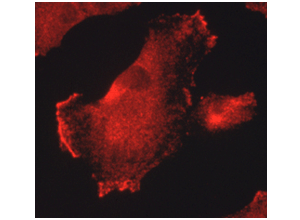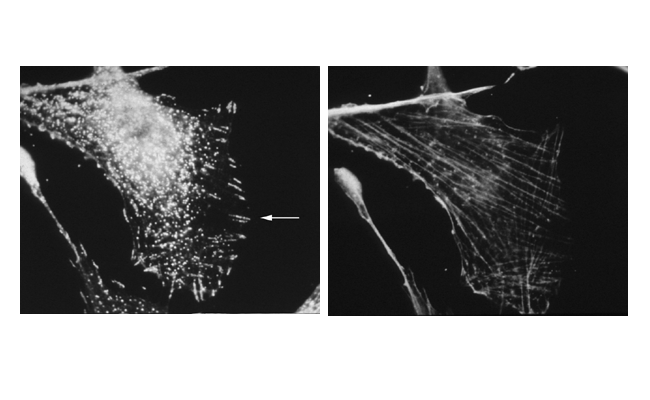Scientists: Cellular Localization

Vault localization has been determined by subcellular fractionation and immunocytochemistry. Utilizing both techniques, the bulk of vaults were found to be cytoplasmic in all cell types examined with most cells containing thousands of vault- specific loci. (one cell type in sea urchin, the coelomocytes, display vaults in the nucleus (Hamill and Suprenant, 1997). However, vault concentration within different rat cell types shows marked heterogeneity (Kedersha and Rome, 1990).
The fibroblast (left) has been stained with an antivault antibody and a secondary antibody linked to the red fluorescent dye rhodamine. Each punctate spot is likely a vault. Vaults are seen at the leading lamellapodia and at adhesion placques.
Below is a fibroblast stained for vaults (left panel) and for actin (right panel). At this high magnification (100X oil), you can see individual punctate loci decorating the ends of actin filaments (arrow). This is the location of adhesion placques which can be revealed by staining with vinculun antibodies (not shown).
Although present in all cells, vaults are most abundant in macrophages and epithelial cells. Vault enrichment in microglia (the brain macrophage) relative to other cells of the brain, allowed Diane Chugani to examine the developmental profile of microglia in rat brain and provided new insights regarding the origin of these cells (Chugani et al., 1991). Vault-positive microglia were seen to enter the brain in two migrations, rather than one recognized by other macrophage markers. Vault antiserum reveals an early migration of ramified microglia entering from blood vessels before embryonic day 15 and subsiding between postnatal days 7 and 14. The second migration consists of amoeboid microglia which appear in the corpus callosum and other large fiber tracks in the first postnatal week. These cells differentiate into ramified microglia between postnatal days 4 and 14 (Chugani et al., 1991)
